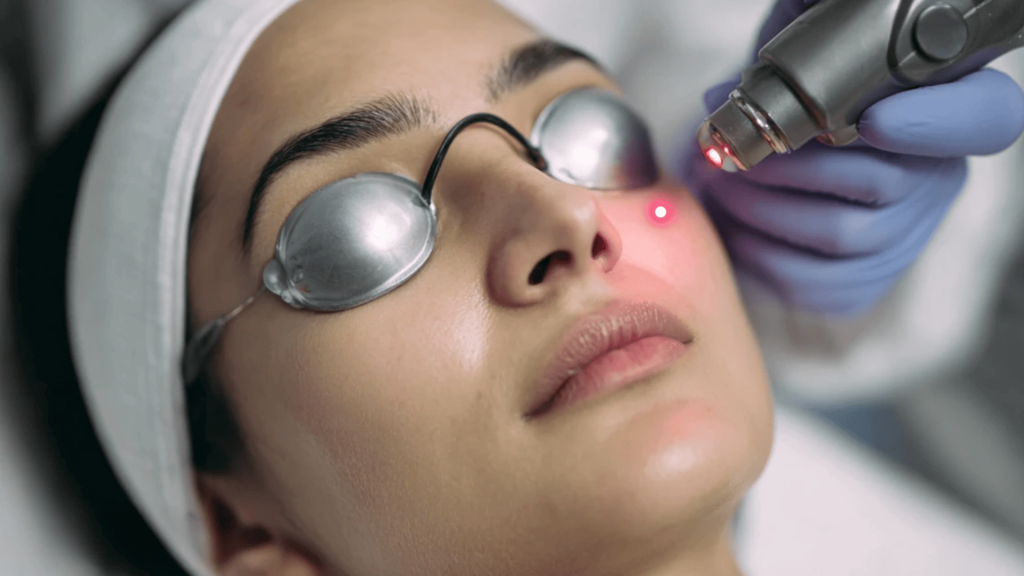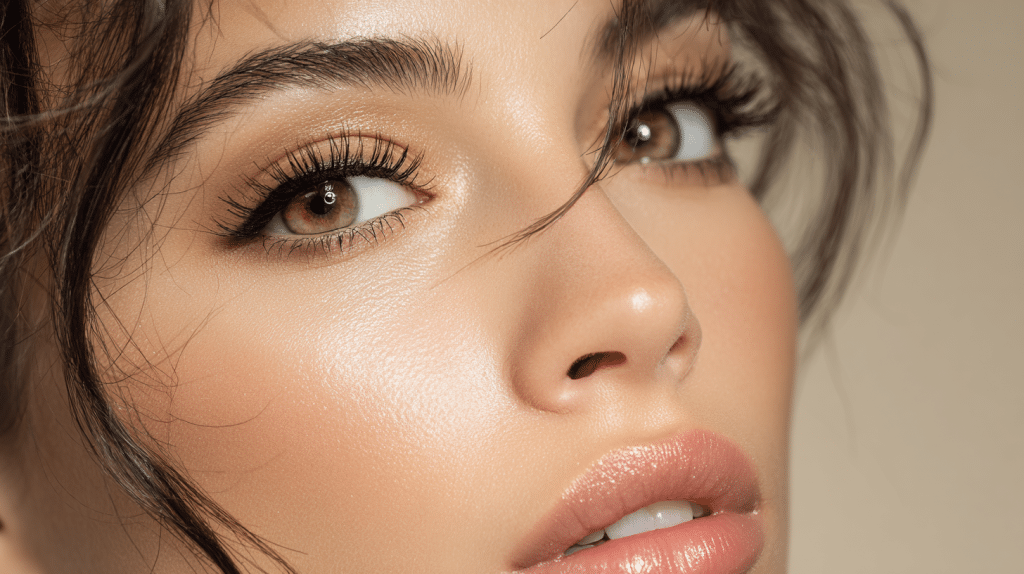Gone are the days when grey hair meant hiding under hats or rushing to the salon for touch-ups every three weeks.
Today’s beauty revolution celebrates silver strands as the ultimate power move, and highlights are your secret weapon for achieving this look with style and confidence.
Think of highlights as your personal stylist’s best-kept trick: they blur the line between your natural color and incoming greys, creating a seamless blend that grows out beautifully.
No harsh roots, no awkward grow-out phases, just a gradual shift that looks intentional from day one.
This approach allows you to test the waters without commitment, maintaining your professional look while gradually revealing your authentic, silver self. Ready to make grey gorgeous?
Why Highlights? Understanding the Process and Purpose
Highlights offer the perfect middle ground between drastic change and gradual updation.
They work by strategically lightening select strands to create natural-looking dimension while seamlessly blending your existing color with emerging grey roots.
What are Highlights?
Highlights involve lightning specific sections of hair rather than applying color from root to tip.
Unlike all-over color that creates uniform coverage, highlights add depth and movement by placing lighter tones strategically throughout your hair, mimicking how the sun naturally lightens strands for an organic appearance.
How Highlights Help with Transitioning
1. Creates a natural dimension that camouflages grey roots
2. Soften harsh lines between processed and natural hair
3. Allow gradual color change without dramatic shifts
How to Smoothly Transition to Grey Hair with Highlights
Transitioning to grey hair doesn’t have to be abrupt or unflattering. Strategic highlights can create a beautiful, gradual shift that embraces your natural silver while maintaining dimension and style throughout the process.
Start with Your Current Color
Begin by assessing your existing hair color and the percentage of grey.
Darker hair requires more strategic highlighting, while lighter shades transition more easily. Understanding your starting point helps determine the best highlighting approach for your unique situation.
Color Selection and Maintenance
1. Cool-Toned Highlights: Choose ash blonde, platinum, or silver-toned highlights that complement grey undertones. Avoid warm colors like golden blonde or copper, which can clash with natural grey.
2. Gradual Lightening Process: Lighten hair gradually over multiple appointments to prevent damage and ensure natural-looking results. Each session should lift color 1-2 levels, allowing the hair to adjust to its new color.
3. Proper Hair Care: Use purple shampoo weekly to neutralize brassiness in highlighted sections. Deep condition regularly and protect hair from heat damage. Healthy hair transitions more beautifully and maintains color longer.
Techniques to Consider for the Perfect Grey Transition
Different highlighting techniques offer unique approaches to transitioning to grey hair. Each method provides distinct advantages depending on your hair type, lifestyle, and desired outcome for your silver transformation.
Balayage
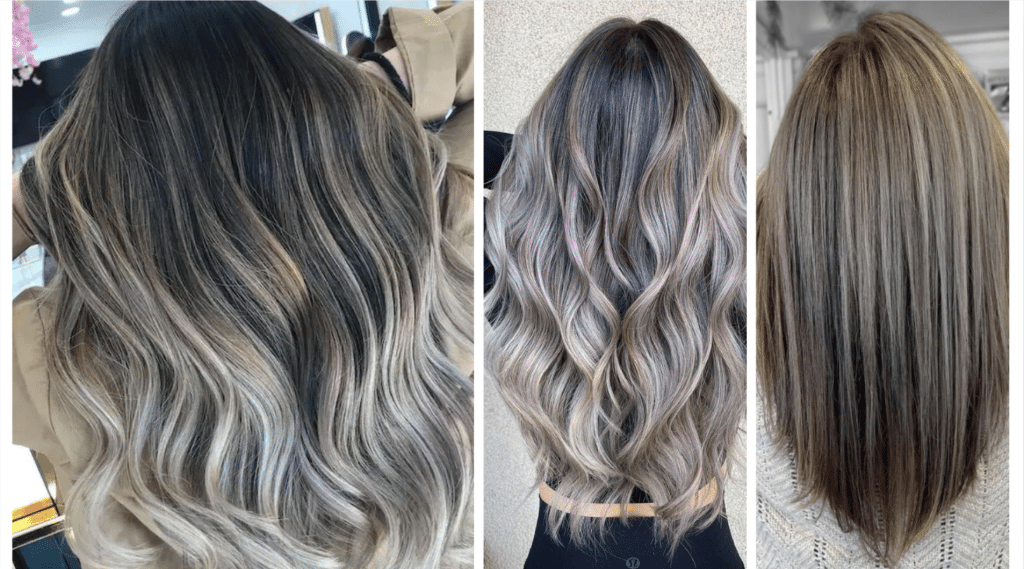
This hand-painted technique creates natural-looking highlights by applying color in sweeping motions.
Balayage grows out beautifully without harsh lines, making it perfect for grey transitions, as it mimics how hair naturally lightens and allows for seamless blending with incoming silver strands.
- Pros: Natural grow-out pattern with soft roots and lower maintenance than traditional highlights
- Cons: Takes longer to achieve dramatic lightning and is more expensive than traditional foil methods
Foilyage
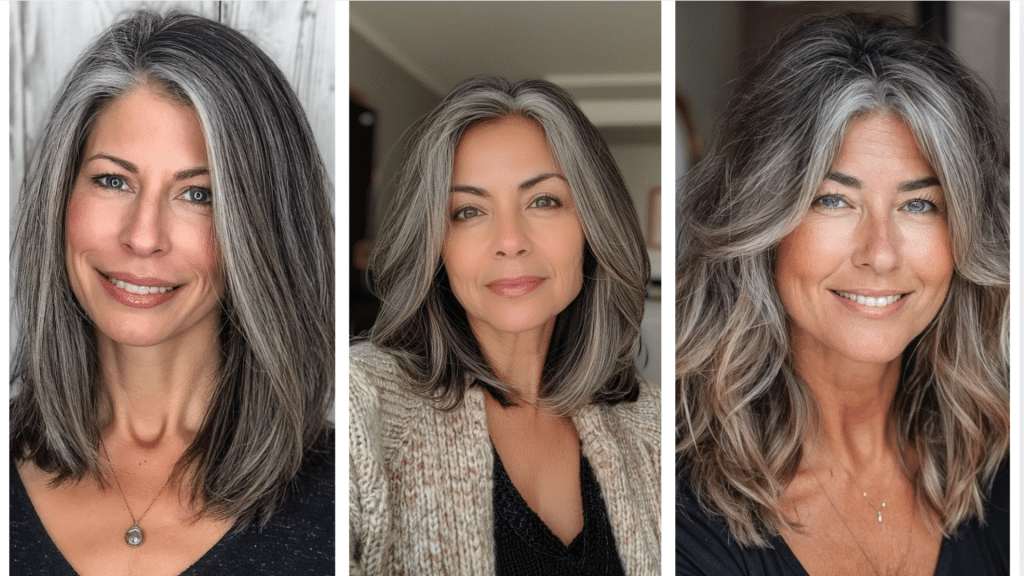
Combining foil precision with balayage artistry, foilyage uses foils for controlled lightening while maintaining natural placement.
This technique adds dimension while allowing grey to show through strategically, creating depth and movement that complements your natural silver tones perfectly.
- Pros: Faster processing time than pure balayage and more control over lightening levels
- Cons: Requires a skilled technician for best results, and can look harsh if not applied correctly
Babylights
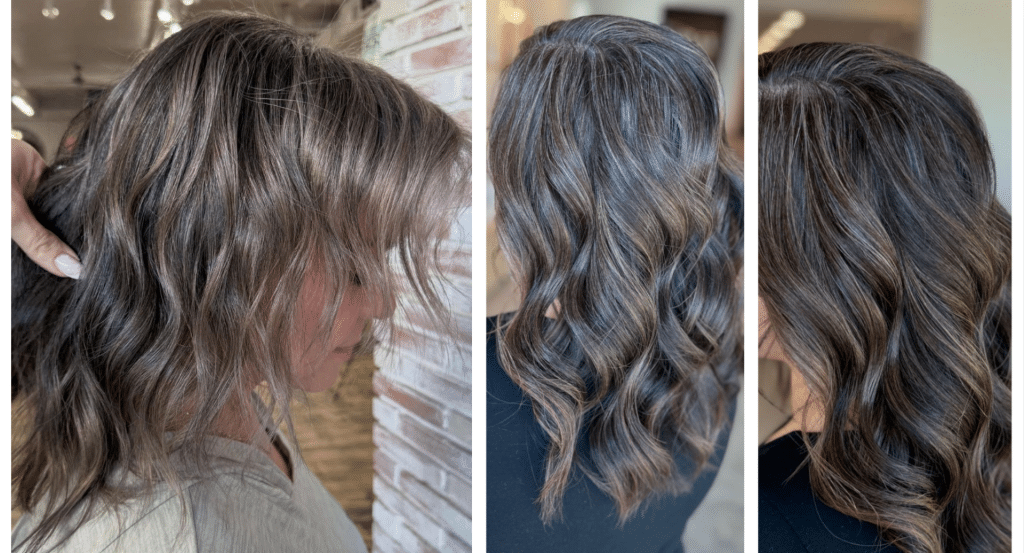
Ultra-fine highlights that replicate childhood sun-kissed hair, babylights create subtle dimension without dramatic contrast.
This delicate technique softly blends with grey hair, providing gentle lightening that enhances natural texture while maintaining a youthful, effortless appearance throughout your transition.
- Pros: Extremely natural-looking results and works well with all hair textures
- Cons: Time-intensive application process, and may require multiple sessions for noticeable change.
Ombre/Root Stretching

This modern technique gradually blends darker roots into lighter ends, extending the time between touch-ups.
Root stretching specifically focuses on softening the line where new growth meets processed hair, creating a seamless transition that celebrates your natural progression of grey.
- Pros: Extends time between salon visits and creates a trendy, modern appearance
- Cons: May look too dramatic for conservative settings and requires regular toning to maintain color balance
Professional Tips for a Successful Transition
Making the switch to grey requires strategic planning and professional guidance. The right stylist becomes your partner in this transformation, helping you achieve a polished look throughout every stage of the process.
1. Consulting with Your Stylist Schedule a thorough consultation to discuss your timeline, lifestyle, and hair goals. Ask about maintenance schedules, realistic expectations, and how your hair texture might change.
2. Choosing the Right Highlight Shade Select shades that bridge your current color and natural grey. Cool-toned highlights work best with silver greys, while warm undertones complement golden or cream-colored natural hair.
3. Maintaining Highlights During Transition Book touch-ups every 8-12 weeks to keep highlights fresh. Use purple shampoo to prevent brassiness and deep condition your hair regularly to maintain its health.
How Often Should You Touch Up? Managing the Grow-Out Process
Understanding the timeline and maintenance requirements helps set realistic expectations for your grey transition.
What to Expect During the Transition
The complete transition typically takes 12 to 18 months, depending on the length and growth rate of your hair.
Hair grows approximately half an inch monthly, so shoulder-length hair requires about two years for full grey coverage. The first few months show the most dramatic changes as your natural color becomes more prominent.
Touch-Up Schedule
Plan salon visits every 8-10 weeks during the initial transition phase. As more grey appears, you can extend appointments to 10-12 weeks.
Root touch-ups become less frequent once you reach 70% natural grey coverage. Some clients prefer monthly toning sessions to maintain color balance, while others opt for at-home maintenance with purple shampoo.
Your stylist will adjust the schedule based on your hair’s growth pattern and personal comfort level.
Conclusion
Transitioning to grey requires both physical and emotional preparation, but the rewards are worth it.
Build confidence during the grow-out phases by styling your hair in ways that work with the blend, investing in quality accessories, and experimenting with makeup that complements your changing tones.
Shift your mindset from hiding grey to celebrating your authentic self. Highlights offer the perfect balance of gradual change and stunning results, saving you time, money, and hair health while maintaining professional polish throughout every stage.
This process creates a sophisticated look that’s uniquely yours. Ready to start your hair transition quest? Book that consultation today and embrace your most beautiful, authentic self.
Frequently Asked Questions
Is It Better to Have Highlights when Going Grey?
Highlights can soften the transition to grey hair by blending natural and artificial tones, creating dimension. However, all-over color or embracing natural grey are equally valid choices depending on personal preference.
What Is the Best Hair Color for Transitioning to Gray Hair?
Ash blonde, light brown, or silver-toned highlights work best for transitioning to gray. These cooler tones blend naturally with emerging gray hair, creating a gradual, flattering transition without harsh contrasts.
How Do You Transition to Gray Hair After Years of Coloring?
Stop coloring and let roots grow, use root touch-up powder between appointments, get regular trims, or gradually lighten hair color to blend with incoming grey more seamlessly.




